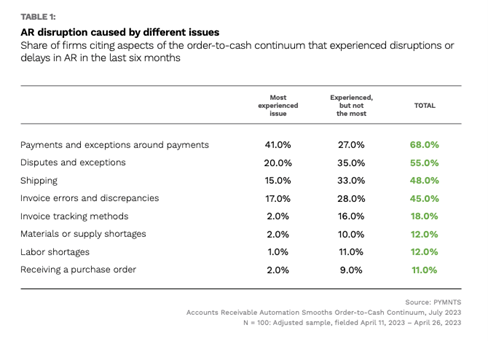
In Accounts Receivable Automation Smooths Order-to-Cash Continuum, a PYMNTS and Corcentric collaboration, 100 CFOs from U.S.-based companies with annual revenues of at least $250 million gave input on the frictions CFOs experienced in the order-to-cash cycle due to payment delays, and how they use automation to alleviate these issues.
For overall context, 68% of CFOs said delays in receiving payments had caused problems for their firms in the last six months, and 41% said it was the most important source of disruption in AR. Errors and discrepancies in invoicing also caused disruptions, according to 45% of CFOs. We found nine out of 10 CFOs want more automation to confront those problems: “It can lessen friction and disruption throughout the order-to-cash continuum. Using digital technology in AR operations can help reduce errors, offer instant tracking and updates, and provide automated customer service,” the study stated.
The survey revealed that 83% of CFOs experienced some delay in the last quarter, with payments identified as the primary source. Automation is credited with reducing AR days of delay, providing instant tracking, reducing errors and automating customer service.

Per the study, “A fragmented approach to order-to-cash, with functions such as credit management, dispute management and cash applications performed by different departments, is the main cause of friction in the order-to-cash cycle.” Organizations lacking the bandwidth and resources to standardize manual processes is a major cause of these issues, and though most CFOs acknowledge that automated solutions can help alleviate such frictions to a large extent, some organizations have not implemented them.
AR Automation Transforms Cash Conversion
Advertisement: Scroll to Continue
Three-quarters of the CFOs PYMNTS surveyed reported a direct impact on cash conversion cycles from automating AR customer service, such as the ability to solve problems faster and the reduction of billing discrepancies. Furthermore, 63% of CFOs noted that the increased processing speed from AR automation reduced invoicing errors.
The fact that 90% of CFOs wish to widen the scope of automation in their AR processes, including customer service, and increase the speed of order processing to reduce invoicing errors and expedite payments, goes a long way in making a case.
AR automation is helping businesses stay a step ahead on liquidity, providing a hedge against economic qualms. Leveraging digital technology applications, instituting automated AR processes, and synchronizing the efforts of payment-related departments are all proven strategies for staying steady in the choppy waters of 2023.
Our research found that 67% of CFOs overall “said their firms probably need more automation in AR and 27% said they definitely need more. Businesses that currently have fewer automated AR functions are more likely than firms with more automated AR to identify further automation as a necessity.” Underscoring that point, 67% of less automated firms said they “definitely” need more automation as well, versus 22% of companies that are further along in their implementation of digital technologies in AR processes.






